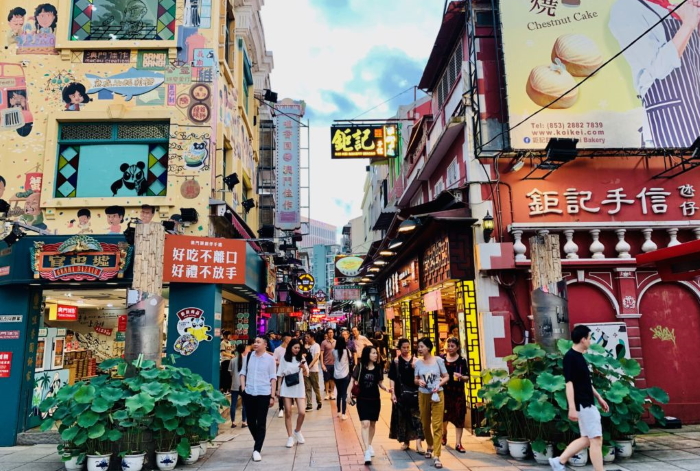
When this 30.5-square-kilometer region is not overshadowed by its more mature neighbor Hong Kong, it is only associated with the strip full of Vegas-style casinos.
But this special administrative region of China has been a Portuguese colony for more than 400 years, and thanks to its history it has developed a unique culture that combines European and Chinese values, cuisine, architecture, and of course entertainment.
Taipa Village is a cultural neighborhood on Taipa Island, which, despite widespread development by the nearby casino resorts, Cotai strip, has managed to cling to its pastel-colored houses, backgrounds, and quiet traditional restaurants. Thus, if you are looking for a slice of old yet modern Macau, here is what you should not miss in the village of Taipa.
Macau on the roof
You will recognize Rooftop Macau by the hipster gatherings in this white-walled boutique that indulge in printed T-shirts, playful stationery, and tricks - but most importantly, for the little drip coffees, you can have, from the mini roof overlooking Rua do Cunha.
Taipa Village Art Space
At Rua Dos Clerigos is the Taipa Village Art Space. This narrow two-story gallery anchors the art side of Taipa Village. Its space presents the work of many artists and hosts a series of workshops and practical classes.
China's answer to Las Vegas
Macau undoubtedly represents China's answer to Las Vegas. The former Portuguese colony has long surpassed the City of Lights with casino game revenues surpassing the entire state of Nevada since 2010. In addition to attracting punters, Macau also has brilliant architecture.
Modern Macau
The story of Macau is one of China's globalization and rise. It is a story of globalization due to the role played by foreign multinational casino companies. And it is a story of China's growth because the economic prosperity of its citizens has allowed them in large numbers to travel, see the world, and play the games.
Macau returned to Chinese rule in 1999 as a special administrative region, which means it has different laws towards the mainland. It is the only part of Greater China (which includes China, Hong Kong, and Macau), where casino and online casino games are legal, making it the only referred casino gaming destination in the country.
In the years before the 1999 surrender, Macao's environment had access to subcontracted VIP gaming rooms. These VIP rooms, which host high-stakes games in a private setting, are another dynamic behind Macao's success. They made the casino gaming experience in Macau different from other casino destinations.
Modern Macau is built on the growth of China and the increased wealth of its citizens. Macao's continued success depends on its ability to attract the mass market player, along with other tourists, as a holiday destination.
António
The eponymous restaurant of Portuguese chef António Coelho is an institution in Macau. Not because the kitchen throws up great Portuguese and Macanese preferences (although that's what happens: try the fried cod cakes and the classic octopus salad), or because of its blue, white, and yellow walls, but because during the weekends, the atmosphere is filled with live music. If you can’t get a meal at António, try La Famiglia nearby, which combines Macanese favorites with Italian flavors.
Rua do Cunha
Unofficially known as the "food street" of Macao, Rua do Cunha is a pedestrian boulevard that stretches along with the core of Taipa Village. As the name suggests (unofficially), it's chocka with snacks, restaurants, as well as numerous Chinese street food dishes.
You should also visit the restaurants on this street, which includes the historic Lord Stow's Bakery, which sells Macau's favorite egg cakes; and O Santos, a traditional Portuguese restaurant whose walls are lined with football memorabilia. A few blocks away are the owner's delicacies O Santos Loja Portuguesa, which sells all kinds of Portuguese delicacies - from canned sardines and olive oil to wine from the Douro Valley.
Avenida da Praia
Avenida da Praia is lined with trees, woven by a huge pond and covered with a water lily pad, on one side and pastel green Portuguese houses on the other side. The houses are part of the Taipa House Museum, five colonial residences that offer a window on what life was like in Macau in the first half of the 20th century. (You will find another example of Portuguese green-mint architecture at the Taipa Museum of History and Columns, a former municipal building that now contains archaeological artifacts and crafts that explain the history of Macao.)
Square of the quarter
This three-level design shop, a café, and a hip hangout offers cool design in the traditional village of Taipa. On the edge of the quiet Largo Maia de Magalhães market, Quarter Square sells all the things you want to buy but don’t need, such as designer dolls and beautiful toiletries. There is an excellent coffee and do not leave without saying hello to the PR director, the French bulldog Copper.
| < Prev | Next > |
|---|





